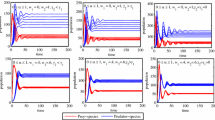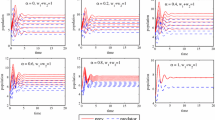Abstract
The study of populations that interact and influence one another’s growth rates is a key component of ecological mathematics. This paper examines a special case of such interaction. It specifically investigates the predator–prey model with two prey and one predator. The three-dimensional Lotka–Volterra predator–prey system’s model stability has been examined using the Takagi–Sugeno (T–S) impulsive control model and the fuzzy impulsive control models. Following the formulation of the model, the global stabilities and the fuzzy solution are provided through numerical simulations and graphical representations with appropriate discussion to validate the applicability of the system under consideration.









Similar content being viewed by others
References
Lotka AJ (1925) Elements of physical biology. Williams and Wilkins, United States
Hale JK (1977) Retarded functional differential equations: basic theory. Theory of functional differential equations. Springer, New York, pp 36–56
Kot M (2001) Elements of mathematical ecology. Cambridge University Press, Cambridge
Murray J (2002) Mathematical models in biology and medicine. Springer, Berlin
Brockett RW (2015) Finite dimensional linear systems. SIAM, Massachusetts Institute of Technology
Li YX, Liu H, Wei YM, Ma M, Ma G, Ma JY (2022) Population dynamic study of prey-predator interactions with weak allee effect, fear effect, and delay. J Math. https://doi.org/10.1155/2022/8095080
Holling CS (1965) The functional response of predators to prey density and its role in mimicry and population regulation. Mem. Entomol. Soc. Can. 97(S45):5–60
Gilpin ME (1972) Enriched predator-prey systems: theoretical stability. Science 177(4052):902–904
Freedman H, Waltman P (1977) Mathematical analysis of some three-species food-chain models. Math Biosci 33(3–4):257–276
Freedman H, Waltman P (1984) Persistence in models of three interacting predator-prey populations. Math Biosci 68(2):213–231
Freedman H, Waltman P (1985) Persistence in a model of three competitive populations. Math Biosci 73(1):89–101
Erbe L, Freedman H, Rao VSH (1986) Three-species food-chain models with mutual interference and time delays. Math Biosci 80(1):57–80
Butler G, Freedman HI, Waltman P (1986) Uniformly persistent systems. In: Proceedings of the American Mathematical Society, pp 425–430
Das S, Borthakur M, Gope B (1988) Need for non-conventional approach in tea pest management. In: Proceedings of the 30th Tocklai Conference, pp 80–89
Kumar R, Freedman H (1989) A mathematical model of facultative mutualism with populations interacting in a food chain. Math Biosci 97(2):235–261
Das S, Barua K (1990) Scope of bio-control of pests and diseases in tea plantations. In: Proc. Int. Conf. Tea Res.: Global Perspective, Calcutta, pp 119–125
Takeuchi Y, Oshime Y, Matsuda H (1992) Persistence and periodic orbits of a three-competitor model with refuges. Math Biosci 108(1):105–125
Ruan S (1993) A three-trophic-level model of plankton dynamics with nutrient recycling. Can Appl Math Quart 1:529–553
Renshaw E (1993) Modelling biological populations in space and time, vol 11. Cambridge University Press, Cambridge University
Gomez JM, Zamora R (1994) Top-down effects in a tritrophic system: parasitoids enhance plant fitness. Ecology 75(4):1023–1030
Kuznetsov YA, Rinaldi S (1996) Remarks on food chain dynamics. Math Biosci 134(1):1–33
Li B, Kuang Y (2000) Simple food chain in a chemostat with distinct removal rates. J Math Anal Appl 242(1):75–92
Van Loon DBJGDM (2000) Joop JA: Parasitoid-plant mutualism: parasitoid attack of herbivore increases plant reproduction. Entomol Exp Appl 97(2):219–227
Xiao D, Ruan S (2001) Global analysis in a predator-prey system with nonmonotonic functional response. SIAM J Appl Math 61(4):1445–1472
Hoballah MEF, Turlings TC (2001) Experimental evidence that plants under caterpillar attack may benefit from attracting parasitoids. Evol Ecol Res 3(5):583–593
Bandyopadhyay M, Chakrabarti C (2003) Deterministic and stochastic analysis of a nonlinear prey-predator system. J Biol Syst 11(02):161–172
Samanta G, Manna D, Maiti A (2003) Bioeconomic modelling of a three-species fishery with switching effect. J Appl Math Comput 12(1):219–231
Maiti A, Samanta G (2005) Deterministic and stochastic analysis of a prey-dependent predator-prey system. Int J Math Educ Sci Technol 36(1):65–83
Srinivasu P, Prasad B, Venkatesulu M (2007) Biological control through provision of additional food to predators: a theoretical study. Theor Popul Biol 72(1):111–120
Turlings TC, Fritzsche ME (2007) Attraction of parasitic wasps by caterpillar-damaged plants. In: Novartis foundation symposium 223-insect–plant interactions and induced plant defence: insect-plant interactions and induced plant defence: novartis foundation symposium 223, pp 21–42. Wiley Online Library
Maiti A, Pal A, Samanta G (2008) Effect of time-delay on a food chain model. Appl Math Comput 200(1):189–203
Maiti A, Pal A, Samanta G (2008) Usefulness of biocontrol of pests in tea: a mathematical model. Math Modell Nat Phenom 3(4):96–113
Gazi NH, Khan SR, Chakrabarti CG (2009) Integration of mussel in fish farm: mathematical model and analysis. Nonlinear Anal Hybrid Syst 3(1):74–86
Pal A, Samanta G (2010) A single species population in a polluted environment. Int J Biomath 3(02):187–204
Manna K, Volpert V, Banerjee M (2020) Dynamics of a diffusive two-prey-one-predator model with nonlocal intra-specific competition for both the prey species. Mathematics 8(1):101
Sahoo D, Samanta G (2021) Impact of fear effect in a two prey-one predator system with switching behaviour in predation. Differ Equ Dyn Syst 1–23
Zhang X, Zou X (2022) Sufficient and necessary conditions for persistence and extinction of a stochastic two-prey one-predator system. J Appl Anal Comput 12(5):1861–1884
Tseng C-S, Chen B-S, Uang H-J (2001) Fuzzy tracking control design for nonlinear dynamic systems via ts fuzzy model. IEEE Trans Fuzzy Syst 9(3):381–392
Tong S, Wang W, Qu L (2007) Decentralized robust control for uncertain ts fuzzy large-scale systems with time-delay. Int J Innov Comput Inf Control 3(3):657–672
Zheng Y, Chen G (2009) Fuzzy impulsive control of chaotic systems based on ts fuzzy model. Chaos Solit Fract 39(4):2002–2011
Wang Y (2012) Stability analysis of predator-prey system with fuzzy impulsive control. J Appl Math 2012
Wang X, Yu J, Li C, Wang H, Huang T, Huang J (2015) Robust stability of stochastic fuzzy delayed neural networks with impulsive time window. Neural Netw 67:84–91
Wu L, Su X, Shi P (2015) Model approximation of continuous-time TS fuzzy stochastic systems. In: Fuzzy control systems with time-delay and stochastic perturbation, pp 269–286. Springer, China
Tanaka K, Wang HO (2001) Fuzzy Control Systems Design and Analysis. John Wiley and Sons, Tokyo Institute of Technology
Wang HO, Tanaka K (2004) Fuzzy control systems design and analysis: a linear matrix inequality approach. John Wiley and Sons, Tokyo
Funding
The authors declare they have no financial interests.
Author information
Authors and Affiliations
Contributions
Both authors have contributed equally to the work.
Corresponding author
Ethics declarations
Conflict of interest
The authors declare that they have no potential con ict of interest in relation to the study in this paper.
Rights and permissions
Springer Nature or its licensor (e.g. a society or other partner) holds exclusive rights to this article under a publishing agreement with the author(s) or other rightsholder(s); author self-archiving of the accepted manuscript version of this article is solely governed by the terms of such publishing agreement and applicable law.
About this article
Cite this article
Singh, K., Kolla, K. Stability analysis of prey–predator model with two prey and one predator using fuzzy impulsive control. Int. J. Dynam. Control 12, 1116–1129 (2024). https://doi.org/10.1007/s40435-023-01189-3
Received:
Revised:
Accepted:
Published:
Issue Date:
DOI: https://doi.org/10.1007/s40435-023-01189-3




